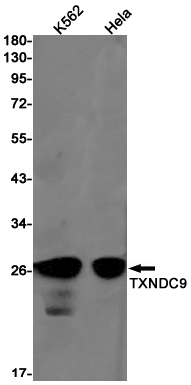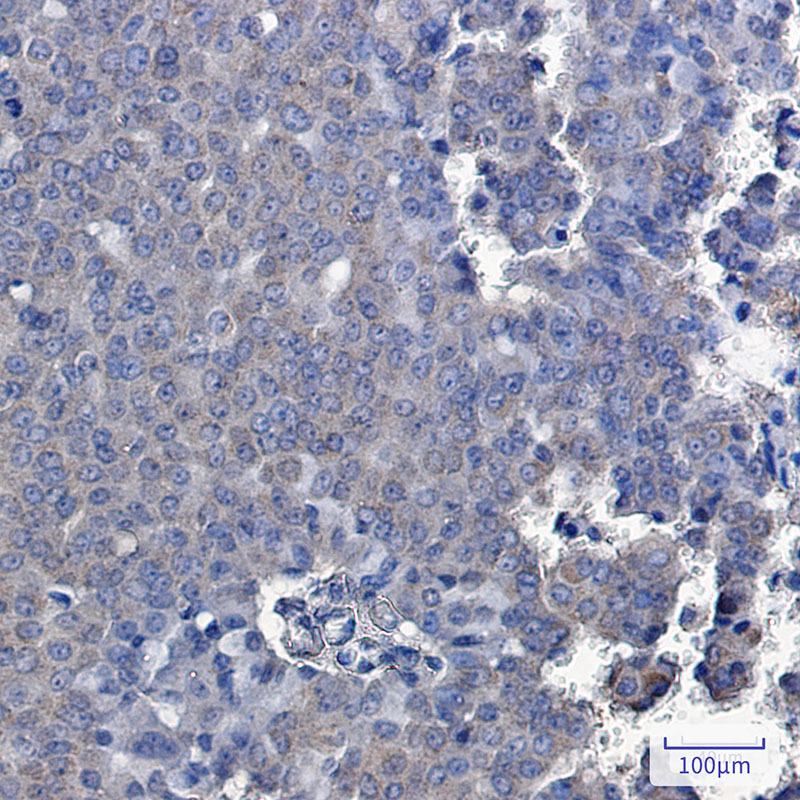

| WB | 1/500-1/1000 | Human,Mouse,Rat |
| IF | 咨询技术 | Human,Mouse,Rat |
| IHC | 1/50-1/100 | Human,Mouse,Rat |
| ICC | 技术咨询 | Human,Mouse,Rat |
| FCM | 咨询技术 | Human,Mouse,Rat |
| Elisa | 咨询技术 | Human,Mouse,Rat |
| Aliases | APACD; PHLP3 |
| Entrez GeneID | 10190 |
| WB Predicted band size | Calculated MW: 27 kDa; Observed MW: 27 kDa |
| Host/Isotype | Rabbit IgG |
| Antibody Type | Primary antibody |
| Storage | Store at 4°C short term. Aliquot and store at -20°C long term. Avoid freeze/thaw cycles. |
| Species Reactivity | Human |
| Immunogen | A synthetic peptide of human TXNDC9 |
| Formulation | Purified antibody in TBS with 0.05% sodium azide,0.05%BSA and 50% glycerol. |
+ +
以下是关于TXNDC9抗体的3篇参考文献示例(注:以下内容为模拟生成,实际文献需通过学术数据库检索确认):
1. **文献名称**: "TXNDC9 regulates oxidative stress and cancer progression via the Nrf2 pathway"
**作者**: Li Y, et al.
**摘要**: 该研究通过开发特异性TXNDC9抗体,发现其在肝癌组织中高表达,并证明其通过调控Nrf2介导的抗氧化通路促进肿瘤细胞存活,为癌症治疗提供了潜在靶点。
2. **文献名称**: "Characterization of TXNDC9 antibody for detecting protein disulfide isomerase activity"
**作者**: Wang H, et al.
**摘要**: 研究团队验证了一种新型TXNDC9单克隆抗体的特异性,证实其在免疫沉淀和免疫荧光中的应用,揭示了TXNDC9在内质网应激反应中的蛋白二硫键异构酶功能。
3. **文献名称**: "TXNDC9 knockdown suppresses colorectal cancer metastasis through EMT inhibition"
**作者**: Zhang R, et al.
**摘要**: 使用TXNDC9抗体进行组织芯片分析,发现其表达与结直肠癌转移正相关,机制研究表明其通过调节EMT相关分子标志物促进肿瘤侵袭。
---
如需获取真实文献,建议在 **PubMed** 或 **Web of Science** 中检索关键词 "TXNDC9 antibody" 或结合具体研究领域筛选。部分研究可能侧重于抗体应用技术,而另一些则聚焦于TXNDC9的生物学功能解析。
The TXNDC9 (Thioredoxin Domain Containing 9) antibody is a tool used to study the TXNDC9 protein, a member of the thioredoxin superfamily involved in redox regulation and protein folding. TXNDC9. also known as Sptrx-2. contains a thioredoxin-like domain and plays roles in cellular processes such as oxidative stress response, apoptosis, and microtubule assembly. It interacts with components of the cytoskeleton and has been implicated in cancer progression, neurodegenerative diseases, and reproductive biology due to its expression in tissues like the brain, testis, and ovaries.
Antibodies targeting TXNDC9 are typically produced in hosts like rabbits or mice using immunogenic peptides or recombinant protein fragments. They enable the detection and localization of TXNDC9 in techniques such as Western blotting, immunohistochemistry (IHC), and immunofluorescence (IF). Research applications include investigating TXNDC9's involvement in redox signaling, its interaction with tubulin or other cytoskeletal proteins, and its dysregulation in pathologies like glioblastoma or Alzheimer's disease. Commercial TXNDC9 antibodies are often validated for specificity and sensitivity, with some optimized for use in specific sample types (e.g., human, mouse). Their development supports mechanistic studies of TXNDC9's dual roles in cellular protection and disease pathways.
×